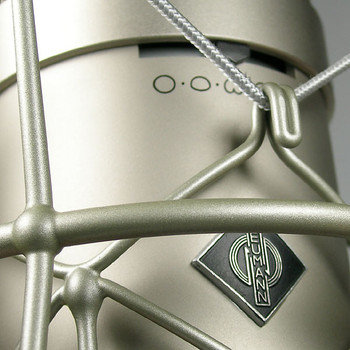Description
Since the 1950s, the Neumann M 50 has been heralded as the ideal microphone for orchestral recording and string scoring. With its phenomenal transient response and unique directional characteristic, this classic mic has endeared many fans, both in the control room and on the soundstage.
The new M 150 Tube takes many of the features from the original M 50 and incorporates them in a very modern microphone. With low self noise, a Titanium membrane and capsule, transformerless tube amplifier and sophisticated power supply, the M 150 Tube is not a reissue but an entirely new microphone in its own right.
Features
- All Titanium capsule
- Unparalleled transient accuracy
- Pressure omni capsule for extended low frequency response
- Modern version of the world-famous M 50
- Transformerless tube amplifier based on the award-winning M 149 Tube microphone
- Ideal for DECCA tree recording and surround miking techniques
- Very low self noise of 15 dB-A
- Stereo sets with consecutive serial numbers
Acoustical features
The Titanium diaphragm of the pressure capsule is 12 mm in diameter and is exceedingly thin. Although Titanium has been known to have unique and desirable characteristics for some time, it has, until very recently, been very difficult to procure in the quality necessary for use in a microphone of this type.
The headgrille is shaped just like that on the original M 50, as requested by various top engineers in the recording industry. Due to mounting the pressure capsule with the diaphragm flush to the surface of a small (40 mm) sphere, the directional characteristic of the M 150 Tube is entirely unique.
At the lowest frequencies, this system is a pure omnipressure transducer with a perfectly circular polar pattern. However, in the mid- and upper frequencies, the pickup pattern becomes more narrow. The M 150 Tube is an ideal microphone for any stereo, 5.1 or 7.1 surround recording, particularly DECCA Tree technique.
Applications
Its special acoustic properties make this an ideal mic for most classical recordings.
- A superb AB stereo pair for perfect balance of direct and reverberant sound
- Decca tree, setup with three microphones
- A highest quality spot (solo) mic
Electrical features
The dynamic range of the M 150 Tube is 119 dB, allowing reproduction of the full musical expression, without restraint. With a low self noise of 15 dB-A, more gain can be used without risk of adding noise to the final product. The transformerless output circuit of this microphone allows for extremely fine reproduction of small signals and low frequency information. Also, long cable runs can be used with no loss of signal quality.
Filter and pre-attenuation
At the rear of the microphone is a –10 dB switch and a switchable footfall filter for the attenuation of frequencies below 40 Hz. In the position “LIN”, a limit frequency of 16 Hz is made active. This is mainly to protect the console inputs from the effects of sub-audio noise (e.g. strong air currents). The –10 dB function is effected by voltage division and should be used only where the danger of over-loading follow-on equipment with very high signal levels is present. This switch does not extend the dynamic range of the microphone, but shifts the output level down by 10 dB.
N 149 A Power Supply
The N 149 A power supply generates the necessary operating voltages for M 147 Tube, M 149 Tube or M150 Tube microphones. It operates with all mains voltages from 100 V to 240 V, 50 or 60 Hz. Mains power is connected through a standard IEC 320 socket. The microphone connects via an DIN-8 connector.
The microphone signal is fed to a XLR 3 M connector. The modulation output is balanced. The N 149 A supplies the bias voltages for the microphone capsule, the filament voltage controlled by a sensor circuit, and a further voltage to generate the plate voltage and other necessary operating voltages within the microphone itself.
The unit produces constant current effecting a soft start of the tube. The KT 8 cable between microphone and power supply can be up to 100 m long. Modulation cable lengths up to approx. 300 m are allowed.
EA 170 Elastic Suspension
It has a swivel mount with a 5/8"-27 female thread, plus a thread adapter to connect to 1/2"- and 3/8" stands.
KT 8 Microphone Cable
Cable with double twist (double helix) braiding as shield. Diameter 5 mm, length 10 m. DIN 8 connectors. Other cable lengths are available upon request! Cable material without connectors are also available. Even if very long (Neumann) cables are used, the electroacoustic characteristics of the microphone are not affected. Only with cable lengths well over 300 m a high-frequency roll-off is noticeable.
Delivery Range
The microphone comes as a set in an attractive Aluminium case, together with the 8-core microphone connecting cable, the N 149 A power supply with plug-in mains unit, the EA 170 full elastic microphone suspension and a dust cover.
Specifications
Acoustical operating principle Pressure transducer
Directional pattern Omnidirectional
Frequency range 20 Hz ... 20 kHz
Sensitivity at 1 kHz into 1 kohm 20 mV/Pa
Rated impedance 50 ohms
Rated load impedance 1 kohms
Equivalent noise level, CCIR 28 dB
Equivalent noise level, A-weighted 15 dB-A
Signal-to-noise ratio, CCIR (rel. 94 dB SPL) 66 dB
Signal-to-noise ratio, A-weighted (rel. 94 dB SPL) 79 dB
Typical SPL (tube characteristic) K < 0,5 %: 114 dB, K < 5 %: 134 dB
Maximum output voltage 8 dBu
Powering Power supply N 149 A
Matching connector microphone DIN8F
Matching connector power supply XLR3F
Weight 800 g
Diameter 78 mm
Length 165 mm











